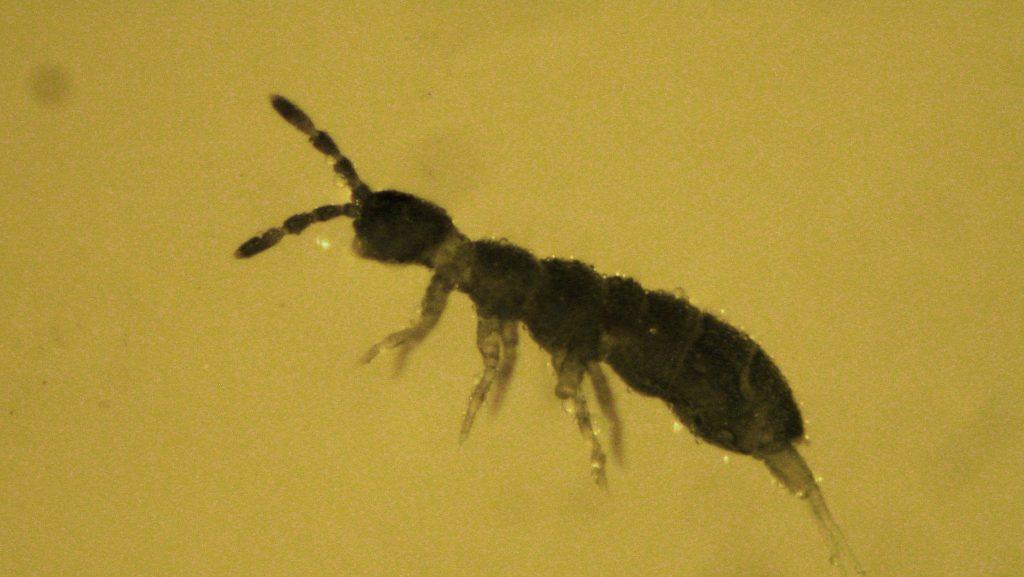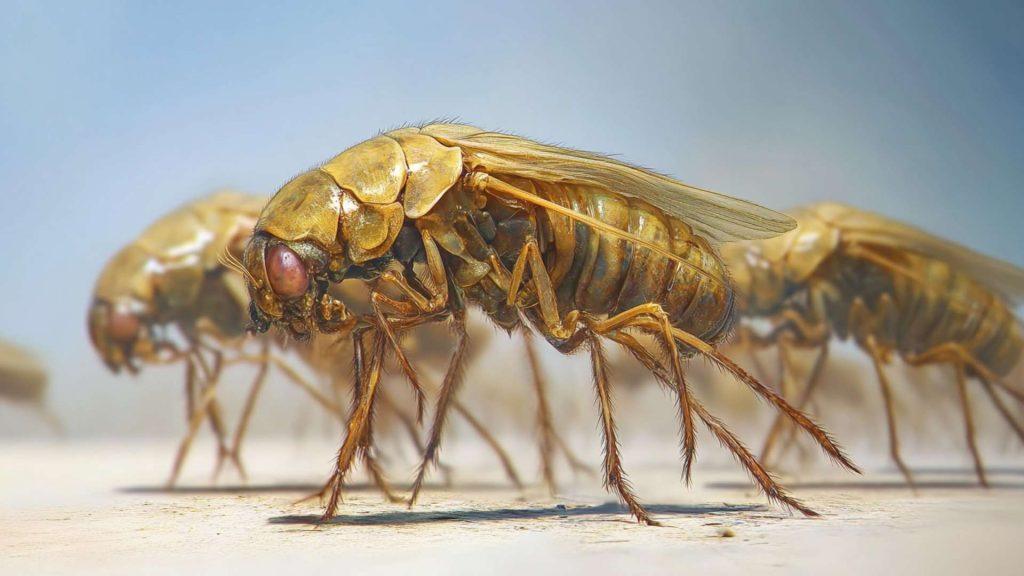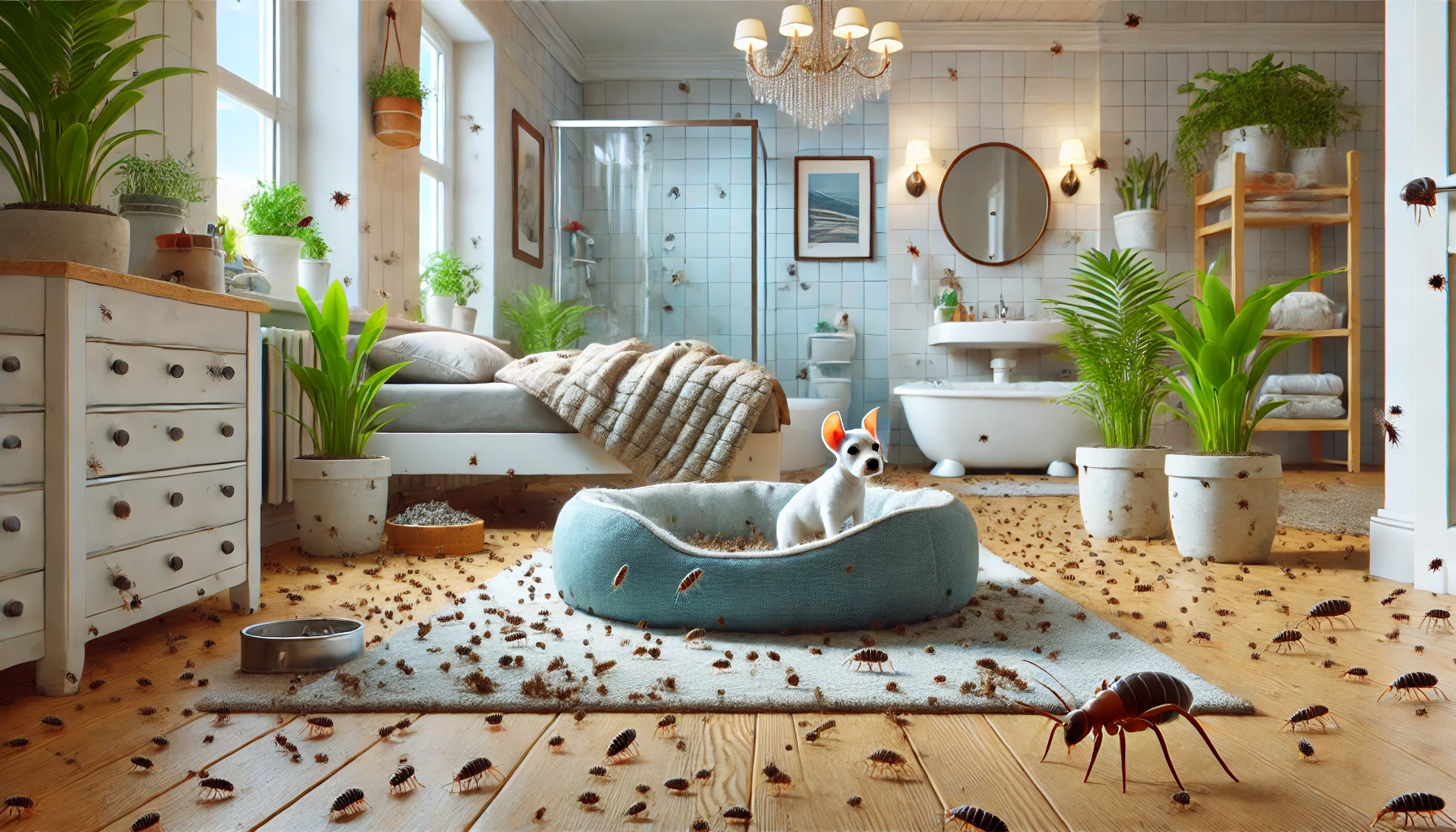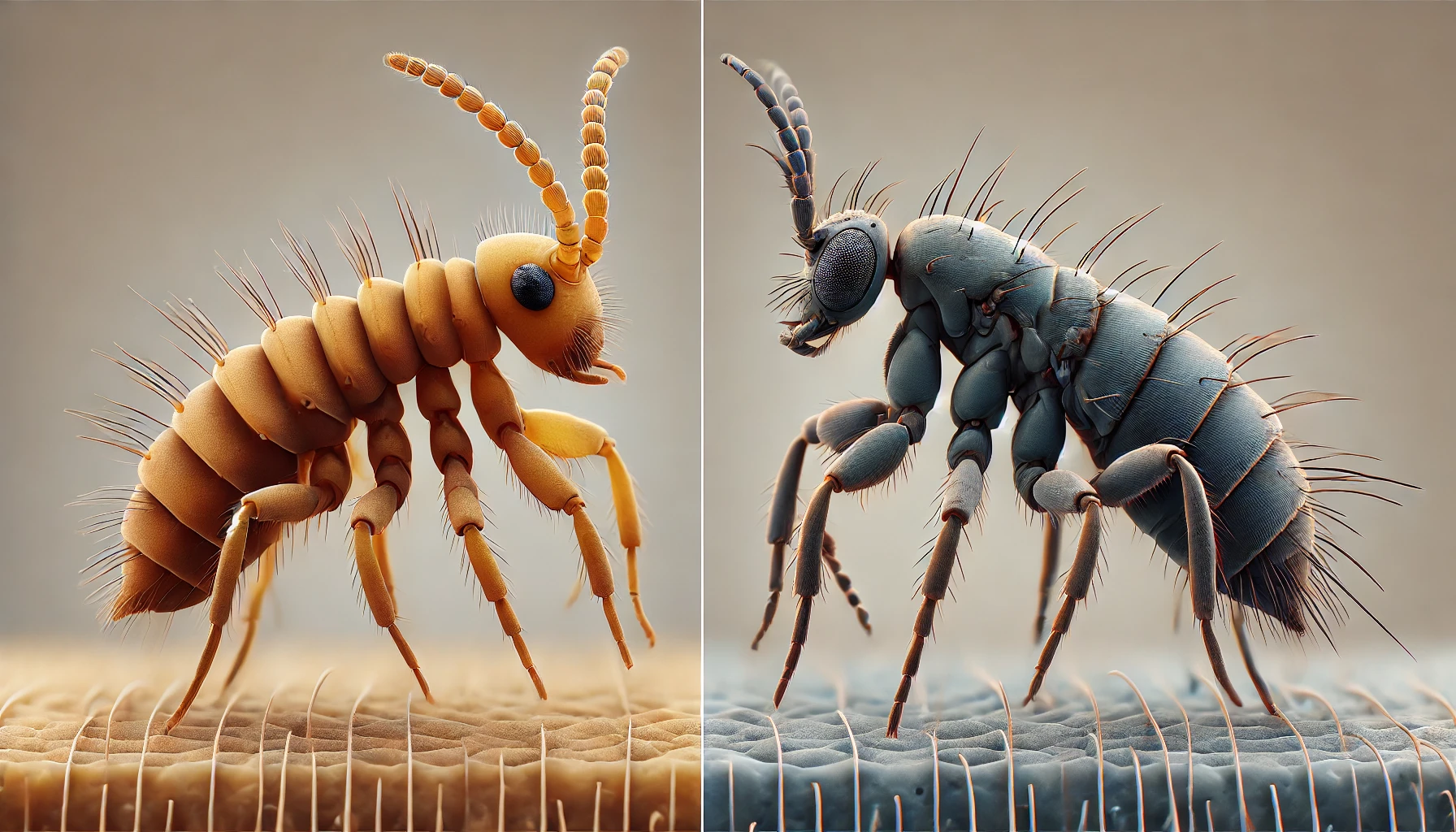Key Takeaways
-
Distinct Characteristics: Springtails are tiny, soft-bodied jumpers using a furcula; fleas are larger, hard-bodied, and jump with powerful hind legs.
-
Health Impact: Springtails are harmless, while fleas bite, cause allergic reactions, and can spread serious diseases.
-
Habitat Preferences: Springtails thrive in damp areas; fleas prefer warm, humid spots like carpets, bedding, and pet fur.
-
Signs of Infestation: Springtails gather near moisture and jump when disturbed; fleas cause pet scratching, bites, and leave flea dirt.
-
Control Methods: Manage springtails by reducing moisture and sealing leaks; control fleas with pet treatments, cleaning, and professional services.
 Springtails and fleas are tiny pests that often cause confusion due to their small size and jumping abilities. But honestly, the similarities stop right there. However, understanding the difference between springtails and fleas is crucial for effective pest control. This article will explain how to identify these pests, their unique characteristics, and practical steps to manage them.
If you’re struggling with either springtails or fleas, our expert pest control services can help you eliminate the infestation quickly and efficiently. Get a free pest inspection visit from our side and keep your home pest-free!
Springtails and fleas are tiny pests that often cause confusion due to their small size and jumping abilities. But honestly, the similarities stop right there. However, understanding the difference between springtails and fleas is crucial for effective pest control. This article will explain how to identify these pests, their unique characteristics, and practical steps to manage them.
If you’re struggling with either springtails or fleas, our expert pest control services can help you eliminate the infestation quickly and efficiently. Get a free pest inspection visit from our side and keep your home pest-free!


Not getting a solution?
Get your free pest control estimate today!What Are Springtails?
Springtails are super tiny—just about 1-3mm, like little grains of pepper hopping around. They’re often grey or black, though some can even look a bit metallic. At first glance, their slender, quick-jumping bodies might trick you into thinking they’re fleas. Here’s the kicker though: springtails don’t jump with legs. Instead, they use something pretty fascinating—a furcula. Think of it like a built-in springboard right under their belly. When disturbed, this furcula snaps open, launching them erratically several inches into the air. It’s kind of their quirky defense mechanism. Springtails are soft-bodied and easily crushed. And here’s the reassuring part—they don’t bite. They just feed on mold, fungi, and decaying organic matter. In fact, they’re actually pretty helpful outdoors, breaking down organic stuff.Characteristics of Springtails
-
 Appearance: Springtails are usually gray, black, or white and have soft, elongated bodies.
Appearance: Springtails are usually gray, black, or white and have soft, elongated bodies. -
 Habitat: These little critters adore dampness. You’ll typically find them hanging out in moist areas around your home—like basements, bathrooms, near plumbing leaks, or even beneath kitchen sinks. Spotting them indoors usually hints at high humidity or mold issues, signaling you might want to address moisture levels in your home.
Habitat: These little critters adore dampness. You’ll typically find them hanging out in moist areas around your home—like basements, bathrooms, near plumbing leaks, or even beneath kitchen sinks. Spotting them indoors usually hints at high humidity or mold issues, signaling you might want to address moisture levels in your home. -
 Behavior: Springtails feed on fungi, algae, and decaying matter, making them beneficial for soil health. They do not bite or pose a threat to humans or pets.
Behavior: Springtails feed on fungi, algae, and decaying matter, making them beneficial for soil health. They do not bite or pose a threat to humans or pets.

What Are Fleas?
Fleas are a slightly different story. They’re a bit bigger—about 1/8 inch—with hard, reddish-brown bodies that are flattened side-to-side. Ever tried to catch one? They’re notoriously tricky thanks to those powerful hind legs, which can send them leaping eight inches vertically or more than a foot horizontally. Quite impressive, right? But also quite a headache. Fleas feed exclusively on blood—mostly animals like dogs and cats, but sometimes they’ll bite humans, too. Their bites aren’t just itchy; they can cause allergic reactions, secondary skin infections, and serious discomfort. If your pet has fleas, you’ll likely spot “flea dirt“—little black droppings—on their fur or bedding.Characteristics of Fleas
-
 Appearance: Fleas are reddish-brown, with flat, hard bodies adapted for moving through fur.
Appearance: Fleas are reddish-brown, with flat, hard bodies adapted for moving through fur. -
 Habitat: These pests typically hitch a ride indoors on pets, multiplying rapidly once inside your home. They quickly settle into carpets, upholstery, pet bedding, and even cracks in hardwood floors. Fleas lay hundreds of eggs at a frightening pace, making it critical to take swift action when an infestation is suspected.
Habitat: These pests typically hitch a ride indoors on pets, multiplying rapidly once inside your home. They quickly settle into carpets, upholstery, pet bedding, and even cracks in hardwood floors. Fleas lay hundreds of eggs at a frightening pace, making it critical to take swift action when an infestation is suspected. -
 Behavior: Fleas bite to feed, causing irritation, itching, and allergic reactions in animals and humans.
Behavior: Fleas bite to feed, causing irritation, itching, and allergic reactions in animals and humans. -
 Health Risks: Let’s be clear—fleas aren’t just annoying; they’re potentially dangerous. They carry severe diseases like the bubonic plague and typhus. Their bites can trigger severe allergies and skin conditions, especially in pets. When it comes to fleas, swift and thorough action is not just recommended—it’s essential.
Health Risks: Let’s be clear—fleas aren’t just annoying; they’re potentially dangerous. They carry severe diseases like the bubonic plague and typhus. Their bites can trigger severe allergies and skin conditions, especially in pets. When it comes to fleas, swift and thorough action is not just recommended—it’s essential.
 Signs of Springtail Infestation
Below are some signs that appears when your house is afflicted by springtail infestation:-
Signs of Springtail Infestation
Below are some signs that appears when your house is afflicted by springtail infestation:-
- Tiny insects appearing near damp areas.
- Noticeable jumping when disturbed.
- Clusters of insects around plant pots or drainage areas.
- Pets scratching or biting excessively.
- Red, itchy bite marks on human skin.
- Presence of flea dirt (small black specks) in pet fur or bedding.

What are the Differences Between Springtails and Fleas
Understanding the difference between springtails and fleas helps in accurate identification and management. Here’s a quick comparison:| Feature | Springtails | Fleas |
|---|---|---|
| Appearance | Tiny (1-3 mm) Soft-bodied, gray/white/black, slender body | Flat/Hard-bodied, reddish-brown, larger up to (1/8 inch) |
| Bites Humans | No | Yes, itchy bites |
| Jumping Mechanism | Uses a tail-like appendage called furcula for jumping | Uses Powerful hind legs for jumping |
| Diet | Feeds on fungi and decaying matter | Feeds on blood |
| Health Risks | None | Causes itching, allergies, and diseases (plague. typhus) |
| Habitat | Damp areas (indoors and outdoors-basements), moist areas (bathrooms, soil) | Warm, humid areas on pets or furniture, carpets |

How to Identify Springtails and Fleas
Identifying Springtails Can you crush the bug easily? If yes, it’s probably a springtail.- Look for small insects in damp or moist areas.
- Disturb them gently; springtails will jump when startled.
- Examine their body—springtails are soft and do not bite.
- Check for fleas on pets by parting their fur to look for insects or flea dirt.
- Observe bite marks on humans or pets.
- Monitor areas like carpets and bedding for small, jumping insects.

Preventing and Controlling Springtails and Fleas
Here are few methods to prevent and control springtails and fleas:Tips for Managing Springtails
-
Seal cracks around doors and windows to prevent entry.
-
Fix leaks and get a dehumidifier running to reduce indoor humidity.
-
Avoid overwatering plants and ensure proper drainage.
-
Regularly dry and clean damp areas like bathrooms and basements regularly.
Tips for Managing Fleas
-
Use flea prevention treatments and products immediately on pets as recommended by veterinarians.
-
Vacuum carpets, upholstery, rugs and furniture frequently, and wash pet bedding in hot water.
-
Consider professional pest control services for severe infestations.





